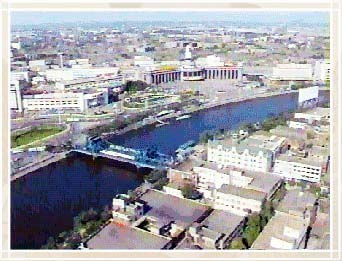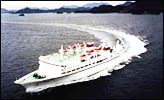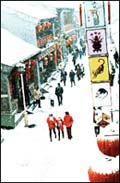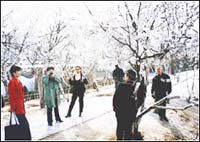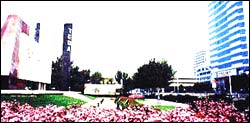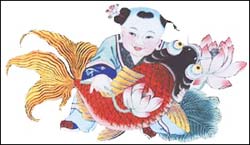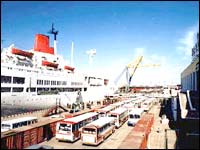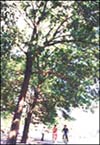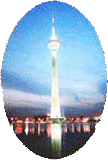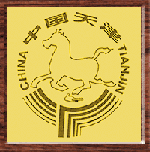History Tianjin
The formation of Tianjin has undergone a long period of time. The name of Tianjin, first emerged during the early period of Emperor Yongle of China's Ming Dynasty, means a ferry crossing where the Son of Heaven has passed. In the second year of Emperor Yongle of the Ming Dynasty (1404), Tianjin started building fortifications and defenses as a strategic military place. In 1860 Tianjin was turned into an open port. |
|
For years its industrial production and port trade volume were only second to Shanghai, becoming the second largest commercial city in China and the biggest financial and trading center in north China. After the founding of the People's Republic of China Tianjin was turned into a municipality directly under the central authorities.
|
Geography Tianjin
Tianjin is located by the Bohai Bay on the west coast of the Pacific Ocean, spanning between 38 degrees 34' and 40 degrees 15' north latitude and between 116 degrees 43' and 118 degrees 04' east longitude.
|
Beijing, the capital of the People's Republic of China, is only 137 km northwest to downtown Tianjin. Tianjin is located in the eighth eastern zone of the International Time Zone.
Climate Tianjin
Tianjin has a warm and semi-humid continental monsoon climate with an average annual temperature of 12.3 degrees Centigrade. The average temperature of July, the hottest month of the year, reaches 26 degrees Centigrade; the average temperature of January, the coldest of the year, reaches 4 degrees below zero. The average annual rainfall of Tianjin is 550-680 millimeters and the rainfall in summer makes up 80 percent of the total of the year.
|
|
Natural Ecological Environment Tianjin
|
The total area of Tianjin is 11,000 square km. Its territory is 900 km in circumference and the length of its coastline is 153 km. The topography of Tianjin with mountainous areas, hilly land and the plain is high in northwest and low in southeast. The area of the plain makes up 94 percent of the total. Rivers passing the city include the main stream of the Haihe River, |
the South and North Canals of the Grand Canal, Ziya Daqing, Yongding, Chaobai and Jiyun rivers, constituting a rich hydrographic net in Tianjin.
Economy Tianjin
Tianjin, the cradle of the national industry of China, is also one of the first and earliest coastal cities opening to the outside world. Tianjin, an economic center of the region encircling the Bohai Sea, has been turned into an important economic center and modern port city in north China. The city is gifted with rich petroleum, terrestrial heat, natural gas, salt and aquatic resources, |
|
perfect transportation, communication and public facilities, an industrial base with a complete array of industrial sectors and a first-class economic and technological development zone of the country. Tianjin is competitive in attracting foreign investment, and the number of foreign-funded enterprises establishes hed in the city stands at 11,500.
Local Culture Tianjin
|
Tianjin is not only a noted historical and cultural city in China, but also one of the birthplaces of culture and art in north China. Nankai University and Tianjin University in Tianjin have occupied an important place in the Chinese. History of education the city boasts of many noted educators, writers, calligraphers, melodies, singers and folk artists who have enjoyed high reputation across the country. |
Tianjin is also the home of quyi (Chinese folk art forms, including ballad singing, story telling, comic dialogues, clapper talks, cross talks, etc.) in north China, and various performing arts are complete in range. Folk arts and crafts such as Yangliuqing New Year pictures, painted clay figurines, kites and carpets have enjoyed high reputation both at home and abroad.
A Survey of Tourist Industry Tianjin
Being close to the Bohai Sea in the east and adjacent to Beijing, Tianjin, with an area of 11,000 square km and a population of 9.4 million, is one of the four municipalities in China directly under the central authorities.
|
|
Tianjin is not only an open port and port city with a fairly developed industry and commerce in north China, but also a famous historical and cultural city in China. The city is being turned into a key economic center and modern port city in north China. In 1998 the city was among the first group of cities to stride to the ranks of top tourist cities of China. The Tianjin municipal Party Committee and government have paid close attention to the development of the tourist industry and regarded the tourist industry as an important industry for priority development and as a new point of economic growth of its GDP. In recent years Tianjin has become one of the regions in China where the international tourist industry has developed apace. In 1998 the number of foreign tourists who visited the city topped 300,000 and international tourist receipt exceeded 200 million US dollars, registering and increase of 8.9 percent and 11.1 percent respectively.
The city received 23.88 million domestic tourists and its tourist income stood at 25.2 billion yuan, showing a growth of 8.9 percent as compared with that of the previous year. The number of the city dwellers who visited other parts of the country came to 5.48 million, million, registering a growth of 53.8 percent as compared with that of the year before. Tianjin has constantly beefed up its tourist construction, and the scale of the tourist industry and the comprehensive receiving capacity have enhanced year by year. Currently, Tianjin has 182 international and domestic travel agencies and 80 hotels with more than 10,000 guestrooms for foreign tourists.
With a complete array of tourist landscapes, Tianjin is blessed with mountain, river, lake and sea landscapes, as well as ancient and modern, Chinese and foreign human landscapes, and rich social tourist resources. The landscape paradigm with the Haihe River as the axis and with Tanggu and Jixian County as both flanks has taken shape in the main. Located in the city proper are the beautiful Haihe River landscape route, the Ancient Cultural Street, which is known in the world, the Food Street, Tianjin Broadcasting TV Tower, Zhou Enlai and Deng Yingchao Memorial Hall which is unique in the country, the Beiping-Tianjin Campaign Memorial Hall, the Science and Technology Hall and various professional museums with distinct features.
There are the Seaside Resort, which wins glory by subterranean heat and thermal spring and the Dagukou Fort Barbette, which is known both at home and abroad. In the outer suburbs of the city are the Huangyaguan Great Wall which has been given the title of the World Cultural Heritage by the United Nations, the National Natural Reserve with the ancient stratigraghic section of the Mesozoic and Palaeozoic eras which is most typical in the world, the Panshan national scenic resort which was visited by Emperor Qianlong for 28 times, the Dule Temple, an ancient temple of a long standing, and the "Scroll of 87 Supernatural Beings" with huge stone-engraving frescos which has been included in the Guinness. On the outskirts of Tianjin are the Shi Family Compound, known as the No.1 dwelling in north China, and the former home and mausoleum of Huo Yuanjia, a noted patriotic martial art master and the founder of the Jingwumen Martial Art School.
Located in the center of the region encircling the Bohai Sea, Tianjin is 120 km away form Beijing, the capital of the People's Republic of China. With the expressway, the modern international airport and the biggest man-made harbour in north China. Tianjin is also an important pivot of the Eurasian bridge. The geographical superiority and convenient sea, land and air networks have furnished convenient conditions for the development of the tourist industry.
The tourist industry of Tianjin is implementing the development strategy of a "big city with a prosperous tourist industry, a flourishing market and a complete array of industries", promoting tourist activities such as sightseeing city tours, specialized exchanges, business and trade conferences, recreational holidays and trips to the rural areas. Tianjin is being developed into an important tourist city in China.
|
City Tree and City Flower and City Tree of Tianjin
Chinese ash, the city tree of Tianjin, belongs to Frainus of R hinocerotidae and its alkali and cold resistance is appropriate for the water and soil and climate of Tianjin.
Chinese Rose, the city flower of Tianjin, is colorful and varied in postures and embodies peace and friendship.
|
City Symbol of Tianjin
The Tianjin Broadcasting TV Tower, the highest building in Tianjin, is No.4 in the world and No.2 in Asia. Looking far into the distance from the tower, one can take a bird-eye view of the city. Currently, the tower has been listed as one of the ten sights in Tianjin. Elegantly called the "Heavenly Tower", it is not only the abbreviation of the Tianjin Broadcasting TV Tower, but also means the "No.1 Tower in Tianjin".
|
|
Tourist Logo of Tianjin
|
The tourist logo of Tianjin is organically integrated with the "Heavenly Steed" of the national tourist sign and plasmodium of the phonetic alphabet abbreviation "TJ" of Tianjin. The plasmodium of "TJ" is also the first letter of "Tourism" in English. The arrangement of its lines can not only imply the characteristics of the river and sea but also embody the soaring flanks and the solid main body. This paradigm tallies with the main body of the downtown tourist area of Tianjin and the two flanks of Tanggu and Jixian County. |
|
